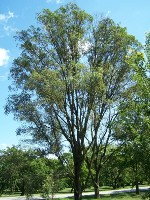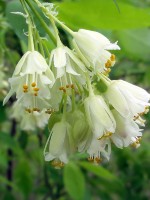Mon-Fri 9am - 5pm Mountain time
Siberian Elm vs American Bladdernut
Ulmus pumila
Staphylea trifolia
PRODUCTION CANCELLED
NOT AVAILABLE THIS SEASON - MIGHT RETURN
Siberian Elm is a small to medium-sized deciduous tree. It has a similar form to American Elm, but smaller, with a more pyramidal habit and shorter lifespan. It is also more resistant to Dutch Elm disease and is very salt tolerant.
Siberian Elm was grown as shelterbelts in the prairies after the Dustbowl disasters, where its rapid growth and tolerance for drought and cold initially made it a great success. It is an excellent shade tree.
Note: Due to it's increasingly controversial reputation for being invasive in warmer climates, we are no longer planning to grow this species for retail purchase on a regular basis.
American Bladdernut is a fast-growing, ornamental shrub native to eastern North America. It can be grown as a large shrub or trained as a small tree. The small, drooping, white flowers are bell-shaped and grow in clusters. They appear in mid to late spring, attracting various pollinators. Well suited as an understory plant as it prefers shady and partial sun location with moist soils.
The blossoms mature into papery seed capsules and have been described as miniature Japanese lanterns. They are commonly used in dried flower arrangements. The seeds found within the pods are edible, and have a taste similar to pistachios. They can be eaten raw, used in baking or made into a sweet cooking oil.
Care should be taken when planting American Bladdernut, as it can spread quickly. It is prone to suckering and will self-seed. Plant the right tree in the right place.
Siberian Elm Quick Facts
American Bladdernut Quick Facts
In row spacing: 2.4 - 3 m (8 - 10 ft)

